#ultimate d20 class fight
Explore tagged Tumblr posts
Text
and we're on to our first full casters, the bards:
feel free to share your reasoning/propaganda. used all of the poll options for this one.
#dimension 20#ultimate d20 class fight#fig faeth#misty moore#rowan berry#d20 agnes#fabian seacaster#barbarella sasparilla gainglynn#vicar ian prescott#sam nightingale#lord squak airavis#delloso de la rue#mother timothy goose#raphaniel charlock#karna solara
109 notes
·
View notes
Text
Swords & Wizardry is an interesting game because while supposedly an 0D&D clone it's much more clearly an "0D&D with all the supplements" clone, which actually in many ways puts it closer to AD&D as far as the rules are concerned. 0D&D was always kind of a weird game and a lot of the ideas that are nowadays taken for granted simply did not exist in the original game by default: the system of rolling a d20 to hit a target number determined by the target's armor class and then dealing damage was originally an alternate rule for the game, and ultimately what the game ended up going with, because the original method of characters being treated as fighting as a bunch of guys in the mass combat game was frankly not that accessible.
So Swords & Wizardry already makes a bunch of choices in how it decides to portray the original game. Not bad choices in my opinion, mind you, but it's clearly a game that is opinionated about how 0D&D should be played.
It also makes some bizarre omissions. There are no number appearing or % in lair numbers given for monsters. Instead we get Challenge Levels (actually just a shorthand for monster level which is used to reward experience points), and the game explicitly mentions using this in adventure design to balance encounters. Which is not something the original game ever did.
Anyway I don't think S&W is a bad game by any means. But it is less useful as a text if one wishes to find out what 0D&D was really like. As a stand-alone game that sort of represents an intermediary step between 0D&D and AD&D it's a perfectly good game imo.
106 notes
·
View notes
Text
I can't be only one, right...?

I wanted to finish the game and then write this post but I gave up. I put in 100 plus hours and just could not go on once I got into act three. Maybe no one will hear my pitiful cry from the void, but I must scream for the sake of my sanity.
I was completely and utterly disappointed by Baldur's Gate 3.
It had huge maps like an open world game yet I had no desire to explore the settings despite their beauty. It had hours of dialogue as an RPG would and yet I found myself skipping characters' responses. The game mechanic structure was inspired by DnD, a story-telling game dictated by some rules, lucky rolls and the extent of players' imagination, yet I was strong-armed into fighting impossibly stacked battles. A story-telling game dependent on the players’ attachment to their and their teammates' characters and yet this game lacked any kind of narrative consistency or depth of feeling.
Larian wanted to make an open world RPG, based off of DND mechanics and somehow did the worst version of all three. The studio touts that Baldur’s Gate 3 has 17,000 possible endings and 2 million words, but to what end? What did this game have to say about what happens when people rise to the challenge and become heroes despite their circumstances or fall into the dark and become the monsters they were supposed to fight? What did it suggest might happen when fate deals you a bad hand but in doing so also helps you find true friends or love with the other? Ultimately, nothing.
BG3 is so large that it ends up being incoherent. No writing or game structure decisions were made to keep the narrative tight and on theme. It urges players to choose a moral alignment, but most decisions, good or bad, seem to end up having little effect in the end. To play the game at all you have to resort to save scumming and that in turn deflates the possible impact of so many plot points of the narrative overall.
Forcing players to save scum in order to progress through the game is terrible design in general. Statistically speaking the bosses make impossible critical hits again and again. I was playing in the game’s “casual mode” and found myself struggling to get through confrontations with bosses that were at a lower level than my own. If you are reading and thinking oh well you are probably not using tactics or spells well, etc., let’s do a little experiment…
Take your d20 (https://rolladie.net/roll-a-d20-die if you don’t have one in person). In the third act of BG3 I had an AC of 13 as a sorcerer with 100 plus HP. Roll your d20 ten times or more. How many times out of ten would your character have gotten to hit mine successfully? Unless an enemy is extremely lucky it should be unlikely that an enemy could hit my character every turn they get. And even if they do they would have to roll for damage which is only a single d6, d8, d10 or d12 plus a modifier at lower levels depending on your class. Again an enemy would have to have an extremely lucky roll to hit me every turn AND deal significant damage. During an in person DnD session that is just a bad night for my character. In a video game on casual mode that is significantly suspicious.
So what you might say. You've made and enjoyed the fanart, memes and etc. You got your $61 worth of playtime. So many other people were fine with the game, what is your problem?
I love video games. They blend so many artforms and tell stories in ways never done before. It is a medium unique to our current century and when historians look back they will view video games as an insight to our culture.
It frustrates me to no end that Baldur’s Gate 3 is considered the next gold standard. Too many games have done open world and RPGs in a fantasy setting far better for Larian (Swen Vincke) to have made the design and writing choices they did with BG3. There are so many podcasts and shows that have written better stories through the DnD format. I am embarrassed for the medium as an artist and frustrated as a player. Players and the industry deserve better than to have artists, actors, engineers etc. burn themselves out creating maximalist behemoths like this game. A game that is beautiful but basically unplayable, narratively, nihilistic and incoherent.
167 notes
·
View notes
Text
so. the nature of epilogue made it really hard to hammer home the fact that. while porter did care about jace he was pulling strings. he was lining jace up to be his perfect little pet sorcerer.
and part of it i think is that i had to cut porter's reaction/discovery of jace's spell thiefing (which is a homebrew boss mechanic i made specifically for jace... and will be borrowing)
eli. if you read this i'm doing bad things to your new adopted wyrmling.
also i go over some mechanical stuff that... justifies jace to me. if you don't wanna read that skip to the giant ANYWAY.
and also. this post. is a doozy and i cannot tell how coherent it is tbh. so uh. if you read the whole thing. i love you.
first thing's first. this "stealing" that jace does was literally me saying fuck rules as written i HATE rules as written i want jace to have cool powers that porter would have IMMEDIATELY been interested in and wanted under his control.
the long and short i have jace as a level 20 divine sorcerer with a unique action that i have crafted. just for him. because if he's not porter's specialest sorcerer he's mine.
Spell Thief 3/Long Rest
You harness the source of your magic and use it to rip a spell from the Weave itself. This is considered extremely dangerous to you and those around you. You do not require components for the spell you steal, unless using this to resurrect a dead creature. The spell you steal does not have to be from your class list but 1) cannot be a spell you currently know 2) cannot be a spell higher than your casting level. (For example, a 5th level caster cannot use this to manifest the Wish spell.) With DM’s discretion, you can use this to steal higher level spells, but this may incur grievous consequences. The first time you use this feature priming the spell is a DC [10+Spell Level] spell check. Upon each success or failure, the DC raises by 5+Spell Level. To use this feature, roll a primer check [1d20 +Spell Casting Modifier +Proficiency] to see if you can manifest the spell. Whether the spell is successfully stolen or not, roll a CON saving throw at the end of your turn to determine the cost of your spell. Use the table provided below to determine the price.
i won't put the table in but the consequences vary from everyone around you has to roll a dex saving throw or take take [Spell Level Summoned] d20 + [Spell Level Summoned] force damage (the sorcerer always fails this save) to you can never cast the spell you stole again to you permanently lose spell slots to there are actually no physical draw backs (20+ save).
so as you can see this is a pretty fucking powerful ability. i'm going to be using it for a boss fight later in my campaign.
but anyway. giving jace this ability automatically makes him interesting to porter. it gives porter a reason to actually pursue jace (besides finding him attractive because i find porter being desperately attracted to jace so funny all the time, sorry man).
ANYWAY.
the (multiple) cut scene(s) i have from chapter 11 is one that gives a lot more detail to porter first bringing up that he knows about what happened to jace in college. but. due to how epilogue is written and presented it was JANKY. like it did not mesh well at all there was no reason for jace to think about what happened in college even IF it was a flashback with porter. the other thought was to have jace pass out after using his spell thief ability and to have a dream about rage!porter we saw in the finale.
this also felt janky and i didn't want to do any more dream scenes after chapter 6.
but this leads to these two cut instances of porter (in their first year of hooking up, because. though they don't really gel imo my first fic does lead into/happen in the same universe). i'm gonna put both of them here to kinda see what i was working with and to show why this ultimately got cut.
version 1 (scene that got cut quickly because the tone didn't match):
Jace had hummed, thought to say something snippy like speak for yourself, but stayed quiet and let himself relax in Porter’s hands. He wasn’t sure how long they had sat like that before Porter ruined it by saying, “Wanted to ask you something.” The memory of the incident—as Jace had taken to calling it during his later years at Aguefort—was fuzzy at best. The campus police reports filed were much more detailed. He had told Porter as much at the time, mood souring as he pulled back. “If you’re that fucking curious just pull up the paperwork. It’s easy enough to find. Especially since you’re a fucking adventurer.” “Hold on—we don’t have to talk about it.” Porter had sounded remorseful. As if he actually regretted upsetting Jace. He still pulled back. The blue and white snowflakes illuminated a dark look on Porter’s face. “Listen—” “I need to go home.” “Let me drive you.”
and version 2 (which almost made it into the final draft):
This—whatever volatile, greedy thing inside him made it possible to do this—it seemed no one could take it from him. Porter had asked him about it once that first year they knew each other—had tried to play sweet at the Moonar Yulenear party and told Jace he had wanted his help on a faculty adventuring quest over the break. You were flagged when I tried to add you to the roster, Porter had said with a frown, said you were… what was the list called. Jace had left the party—drove home tipsy and ignored Porter’s calls and messages for the next three days. He’d been intent on ignoring Porter the entire break until he showed up at Jace’s townhouse with a coffee and breakfast sandwiches. Didn’t think you were gonna be rid of me for three weeks, did you? He’d been charmed. And Porter didn’t ask about the list again.
i am kind of disappointed that this ultimately was decided to be not.... jace enough to make it into the final draft but. what i'm about to say is going to reveal WHY it could not make it into the final draft:
porter, to me, is a little too... overt. almost creepy in theses scenes (which i was angling for). but for the context of epilogue where jace is romanticizing and pining for this idealized porter he has in his head... it didn't work.
this is porter angling to get something from jace. he's fishing for information about what jace did in college and whether jace felt remorse over it or not, he shuts it down and porter then has a reaction to it. in version 1 even jace manages to notice a "dark look" and this is in their first year of being a situationship!
this is a little peek into what epilogue porter actually was. it's really hard to get a read on him in epilogue since he is a memory/ghost for the entire story and we are viewing him in this hopeless, searching for meaning jace who cannot see himself without this man who has abused, used, and killed him. he is coping by only remembering the good things about porter-- he is seeing porter as a man who loved him so much he had to kill him, who wanted jace so much that he was doomed to never leave.
it's what he's always wanted-- no one has ever wanted him like this, chased him like this. but the problem is we can't see porter's thoughts in this. as author of this horrid little universe i know the approximate truth that these two unreliable men hold for each other and i can say that i do think porter loves jace. he sees it as love, but there's a lot of dark shit. a lot of isolating, patronizing, possessive unhealthy ownership happening that makes it, imo, inevitable for jace to break down the way he does.
he doesn't want the reader to see that in epilogue though.
he wants to frame this as a i need to get back the only person in my life who loves and gives a shit about me.
but in his need to do this, he glosses over really dark shit about porter and their relationship.
to continue that version 1 scene a little:
Porter rubbed the curve of his hip and smiled indulgently. “C’mon, Jace. I’m being a considerate coworker.” That had made it worse, somehow. “Sober me up. You do it all the time.” “Tapped out—some of the seniors got rowdy last period.” Jace rolled his eyes. “Fine. Take me home. One condition.” Porter hummed, still rubbing circles along Jace’s hip. “No. Asking me about.” He waved his hands vaguely. Porter had agreed, then stood and tucked Jace under his arm. Told everyone they passed: Stardiamond’s cut off. Just looking out for him. “You,” Jace had announced as Porter fiddled with the climate control. “Did that on purpose.” Porter grinned at him. “It’s winter break. Everyone will forget about it.”
[...]
“It was an accident,” Jace finally said, head feeling unfortunately clearer. He recognized the streets. They weren’t going downtown; they were still in Tillering—winding the streets to Porter’s house. “It was… like a wild magic surge.” Porter had stayed quiet, keeping his eyes on the road. Snow was finally beginning to fall (what a strange detail to remember so clearly). Despite the empty roads, Porter signaled his turn and as he was slowly easing onto his street he finally spoke: “Didn’t think you were that kind of sorcerer.” “I’m not.”
i think this is a perfect example of the kind of read flags jace was ignoring and the kind of red flags he wouldn't want in his narrative. (there's a reason this scene is cut.)
porter does a few notable things here, right:
ignores jace's boundaries- jace puts distance between them. porter ignores it and grabs him. intimately. and continues the contact.
porter tells everyone he's taking jace home. something jace doesn't want (especially since this would be like 5 months into them fooling around.)
he then, instead of taking jace to his townhome, takes jace to his own house. when he knew jace didn't want to go there.
like. jace doesn't react to these- he sees them as flattering in a way. but it's bad. porter starts this shit early and it doesn't stop. jace just doesn't tell us about it in epilogue because he doesn't deem it good enough for his narrative of the man who wanted him so bad he was willing to sacrifice him and bringing him back all wrong.
also... in chapter 6 jace does give the tiniest nod to porter and this whole college situation but it never comes up again because jace doesn't think it's important outside of his dream:
How strange to think that Porter had known about that in this moment. Had that been what made Porter pick him?
he knows porter knew about his spell thief ability. we just don't get to understand it until much later.
THIS LITERALLY WENT NOWHERE I'M SORRY. but let me leave you with a cut bit that almost made it into the final draft and that i now regret cutting, but hope you can see why i felt it necessary to cut:
He wonders. Would Porter have been excited at the prospect of Jace’s talents if he had told him that night? Would he have asked in hushed tones if Jace could still do that. Could he still steal magic—rip spells that weren’t his out of the weave itself? Would Jace have seen earlier the way Porter might have wanted to use him? Porter had never been shy about saying how he loved Jace’s magic—loved watching him use it, loved how powerful he knew Jace would be. I’ll make you more than you are, Porter had whispered in his ear one night as he pressed Jace into the mattress. Imagine it, pet. Jace stares at the spot of blood on his carpet—aware of the ache in his bones, the blood under his fingernails and wonders, faintly: Did Porter ever want him? Was it always his magic? Did it matter? He thinks. Porter had felt so inevitable. Does it matter? He gets up. There’s one way to find out.
#.txt#.writing#uhhhhhh#i don't think this makes sense#and it's not really what i meant to write but.#enjoy? if you read it?#epilogue tag#calling this the porter is a creep but jace doesn't want YOU to think that the meta#i'm half joking
24 notes
·
View notes
Text
A History Lesson - Looking back at D&D’s history

Hullo, Gentle Readers. Well, this is the 5th Monday in March, and that means I get to write about anything I want! It’s also my birth month, which means it’s my anniversary of getting into D&D (42 years!), and that has me feeling nostalgic. Coupled with a discussion I had recently with some friends, I thought it would be fun to look back at the various editions of D&D and give you all a bit of history. I’m not going to get into Gygax vs Arneson or any of that. I’m only talking about the published game itself, not its creators or its storied origins.
The original D&D (or OD&D as it’s sometimes called) came in a small box. It had three booklets inside - Men & Magic, Monsters & Treasure, and The Underworld & Wilderness Adventures - along with reference sheets and dice. Each was softcover and roughly the same dimensions as a DVD/BluRay case. The game was pretty rudimentary - for one thing, it assumed you already had a copy of Chainmail, D&D’s direct wargame predecessor. It also recommended you have a game called Outdoor Survival for purposes of traveling through the wilderness. It had only three classes - fighting man, magic-user, and cleric - and nothing about playing other races. It did have the insane charts that 1st edition would ultimately known for, and it was possible to play a pretty fun game of D&D with it, as its popularity would come to show.
The game expanded through similar chapbooks - Greyhawk, Blackmoor, Eldritch Wizardry, Gods Demigods & Heroes, Swords & Spells. With the exception of the last one, each brought new facets to the game - new classes like Thief and Monk, new spells, new threats. It was clear the game was going to need an overhaul, and it got one.
I consider this overhaul to yield the real “1st Edition”, as so much of the game didn’t exist in those original games. The game split into a “Basic” game, just called Dungeons & Dragons and Advanced Dungeons & Dragons.
The basic game was a boxed set that included a rulebook, a full adventure module, and dice...or, well, it was supposed to contain dice. The game was so popular and new in those days that demand for dice outstripped production. My copy of D&D came with a coupon for dice when they became available and a sheet of “chits” - laminated numbers meant to be put into cups (we used Dixie Cups with the name of the die written on it), shaken, and a random number pulled out without looking. It was meant to introduce new players to the game, so it was a trimmed down version. Races were human, elf, dwarf, and halfling, and classes were fighter, cleric, magic-user, and thief. The box only included rules for going up to 3rd level, with the intention that players would then graduate into AD&D. This is where I joined, with the old blue cover box set and In Search of the Unknown, before Keep on the Borderlands even existed.
AD&D was the game in its full glory. Along with the races I mention above, we got half-elves, half-orcs, and gnomes. The four basic classes also had sub-classes, like paladin and ranger for the fighter, druid for the cleric, illusionist for the wizard, and assassin for the thief. There were rules for multi-classing, as well as “Dual-classing”, a sort of multi-class variation for humans only, which, when done in the correct combination, could yield the infamous bard...which didn’t actually yield any bard abilities until around level 13 or so.
This edition had 5 different saving throws for things like “Death Magic”, “Petrification & Polymorph”, “Spells”, and so on. It had the infamous Armor Class system that started at 10 and went down, so that having a -3 AC was very good! It also had specific attack matricies for each class; you would literally look on a table to determine the number you needed to roll on a D20 based on your class, your level, and your opponent’s armor class. It was fun, but it was very complicated.
It also had some, frankly, shitty rules. There was gender disparity in terms of attributes, which my group totally ignored. Because the game designers wanted humans to be a competitive the game, and because non-humans had so many abilities and could multiclass, non-humans were severely limited in the levels they could achieve in most classes. In fact, some classes, such as monk and paladin, were restricted only to humans.
As the years went on, things got a bit muddled. It probably didn’t help that the rules in Basic D&D and AD&D didn’t perfectly line up. In D&D, the worst armor class was a 9. In AD&D, the worst armor class was a 10. All of this led to an overhaul, but not one considered a separate edition. AD&D mostly got new covers and new books, like the Wilderness Survival Guide and Dungeon Survival Guide, Monster Manual 2, and the Manual of the Planes. It got a number of new settings, too. In addition to the default Greyhawk setting, we got the Forgotten Realms setting for the first time, details of which had been appearing in Dragon Magazine for years, thanks to the prolific Ed Greenwood. We also, eventually, got the whole Dragonlance saga, which yielded the setting of Krynn.
In this new version, Basic D&D broke off into its own game system to some degree. Elf, Dwarf, and Halfling started being treated like classes rather than races, with specific abilities at different levels. Higher level characters could be created using progressive boxes - Expert, Companion, Master, and Immortal, each with its own boxed set and supported by Mystara, a completely different setting that got its own updates over the years. It was odd, because D&D essentially was competing for players with AD&D, and I remember arguments with friends over which version was better (I was firmly in the AD&D camp.)
In 1989, when I was in college, they finally brought forth 2nd edition D&D. This streamlined things a little. Armor Class still went down, but now attack rolls boiled into a single number called To Hit Armor Class 0, or THAC0. It made the whole process of figuring out what you needed to roll a bit less cumbersome, but it was still a bit awkward. The classes got a lot of overhaul, including making Bard its own core class. But what I remember best about 2nd edition was the boom in settings. This was the age of settings, and many beloved ones got started, including Dark Sun, Planescape, Ravenloft, and Spelljammer.
It was also the age of the “Complete Handbooks”. They brought out splatbooks about every class and race in the game, as well as books expanding several concepts for the DM, such as the Arms & Equipment Guide, the Castle Guide, and the Complete Book of Villains. There were also splatbooks about running D&D in historic periods, such as Ancient Rome, among the ancient Celts, or during the time of the Musketeers. The game got new covers for the rule books again, and a bunch of books about options started coming out. It was a boom time for books, but many people complained there was too much.
Without going too deep, TSR ended up in severe financial troubles. They declared bankruptcy, and there was real fear of the game going away. And then Wizards of the Coast (WotC) stepped in. They helped TSR get back onto its feet, and they helped produce some modules specifically engineered to help DM’s bring an end to their campaign...possibly even their whole campaign world...because something big was coming.
That something big was, of course, 3rd edition D&D. The game got majorly streamlined, and many sacred cows ended up as hamburger. AC finally started going up instead of down. Everything was refined to the “D20″ system we’ve been playing ever since. Races could be any class. There were no level or stat limits for anyone. After years of the game being forced into tight little boxes, it really felt like we could breathe. I had stopped playing D&D, but 3rd edition brought me back into the fold. I often say that 3E was made for the players who’d felt constricted and wanted more flexibility.
The trouble with 3E, and its successor 3.5, is that it was still a dense and difficult game for newcomers to get into. It’s been acknowledged that D&D essentially created many of the systems we see and know in other games - experience points, leveling up, hit points, etc. But trying to break into the experience for the first time was difficult. The look of 3E was gorgeous, but I understood that it must seem awfully daunting to someone who’d never played.
4E and its follow-up, Essentials, was an attempt to course correct that. They tried to make this edition incredibly friendly to new DMs, and, frankly, they succeeded. By creating player classes and monsters and magic-items that were all very plug and play, they did a great job of creating a game that someone who had never DMed before could dive into with no experience or mentor and start a game pretty easily. Encounter design was given a lot of ease, and there were promises of a robust online tool system that would help out with many of the more tedious aspects of playing.
There was also a lot of shake up in terms of choices. Suddenly, new classes and races were proliferating like crazy. We got the dragonborn, the tiefling, and the eladrin right in the core book, but we said good-bye to the gnome and half-orc at first. Suddenly the warlock was the new class everyone wanted to try. We got paragon paths and epic destinies that would really shape a character as time went on. The game went very tactical, as well, which some of us loved. The concept of rituals came into the game. Later books like the Player’s Handbook 2 and 3 gave us back gnomes and half-orcs, and also gave us minotaurs, wilden, shardminds, and githzerai. We got new psionic classes, brand new class concepts like the Runeknight and the Seeker...
But there was a tremendous backlash. People felt that, in making the game so very plug and play, they’d taken a ton of choice away from the players. Without the tools (which were never that robust, frankly), it was almost impossible to navigate the massive panoply of options. And, worse, it was harder and harder to develop encounters without those tools. People complained that the game had gone more tactical in order to sell miniatures and battlemats. Given that I have never played the game without miniatures and battlemats (since I started in the days when D&D was still half-wargame), I found this odd, but I also understand my style of play isn’t everyone’s.
The one argument I will never understand is that it didn’t “feel” like D&D, or it was somehow ONLY a tactical game and not a role-playing game any more. Again, given that the original game didn’t even call itself a role-playing game, this felt odd. Personally, I roleplay no matter what game I’m playing. If I’m playing Monopoly, I’m roleplaying, doing voices, and pretending to be something I’m not. I honestly enjoyed 4E, and I know a lot of folks who did, too. A lot of it may simply come down to style of play. But I also enjoyed all the games that came before, including Pathfinder. To paraphrase the YouTube content creator The Dungeon Bastard, “Does your game have dungeons? Does it have dragons? Great. I wanna play.”
As a sidenote, in the months leading up to 4E’s release, a lot of internet videos were released by WotC emphasizing the nature of change and talking about differences in the rules. They also released some preview books showing the direction they were heading. WotC must have anticipated that people were going to find this edition very different indeed. They also cleverly brought in some very funny folks - Scott Kurtz from PVPOnline and Jerry Holkins & Mike Krahulik from Penny Arcade - and got them to play D&D for podcasting purposes. Looking back, this must’ve brought in a lot of listeners who might never have played D&D and given them a reason to try it out.
After its release, WotC clearly noted that missteps had been made, as this edition of the game was losing them players. They began work on what they referred to as D&D Next, and, this time, they did massive amounts of playtesting, some of which I participated in.
I don’t feel like I have to describe 5E to any of you, Dear Readers, as you could go to virtually any store and pick it up. I am a big fan of 5E’s simplicity and elegance, and I suspect this is the edition of D&D we’re going to have for some time to come, especially given its popularity. Given the effect of podcasts like Critical Role (and I might save an article on Critical Role’s importance to D&D until my next Freestyle article), D&D is likely more popular now than it’s ever been, with a much wider and more diverse audience than ever before.
I know I’m painting with broad strokes here, but I hope this was, at least, entertaining, and maybe you learned something, Gentle Readers. Until we next meet, may all your 20s be natural.
116 notes
·
View notes
Text
my theory inb4 the finale:
the mysterious cube at niirdal-sarqet was a pre-age of arcanum training tool for prospective spellcasters.
the design of the cube all points to an exceptionally ancient time. it echoes the same long-forgotten mystique as the age of arcanum. the language embedded in it is qoniira—a language older than celestial. some of the power inside hearkens back to dunamancy, the manipulation of time and space, which believers in the luxon allege existed before everything else along with their deity. it's covered in archaic versions of the gods' symbols—not just the prime deities, all of them (excepting the luxon). betrayer gods included, their iconography neutral and non-menacing, as if the people who created it... didn't recognize them as betrayer gods in the first place.
according to the story of the founding in the EGtW (explorer's guide to wildemount, ch. 1), the betrayer gods were only seen as betrayers after the war with the primordials. before then, the gods were just the gods—the creators. all of them together had created the peoples who formed families and cultures and nations. qoniira likely dates to this age.
mortals didn't know how to spellcast at this point beyond divine gifts. so when the primordials, who had claimed the realm for themselves too, eventually decided to wreak destruction and return the realm to elemental chaos, the mortals were nearly defenceless.
this was when the schism between the gods occurred: the ones who would become the betrayer gods fell apart to grief and rage and wanted to wipe the slate clean; let the primordials destroy it all. the ones who would become the prime deities wanted to wage war and save the world they'd created from the primordials. the prime deities ultimately accomplished this by teaching mortals arcane magic. (this was the factor that led the following era to become the age of arcanum.)
why i think the cube was a tool to teach arcane magic:
it's fairly clear that the cube was meant to be both dangerous and easy to access, the way we saw it in episode 7. the command phrases to open it were in qoniira—this would've been easy for anyone native to the tetrarchy to read. even anyone not native or fluent in qoniira would still be able to figure it out with some dedication, as the exu gang made pretty evident. the lack of barrier to activating the cube tells me that access was intended to be unrestricted.
the stone guardians appeared in response to people physically interacting with it. mechanically, each player had to make a wisdom saving throw every time they came in contact with a new face/platform while the cube was active; if they failed, they took 2 points of damage and had their max hp reduced by that amount as a guardian emerged from the stone, apparently fueled by the player's health.
each time this wisdom save was a success, aabria explicitly described the respective player seeing the stone roil before stopping at their attention, unable to form.
before the cube opened, it had begun to move. fearne deliberately forced her will into the cube to command it to stop moving, rolling a 23 spell attack. it listened to her and didn't move; it broke open in place.
recall the command phrases to activate the cube.
the universe above / the universe within / remember what came before / decide what happens next / provide for all / a shield to protect.
note "decide what happens next." this is a phrase meant to be a command to the reader too. in episode 6, tetrarch thrascuur told the party that power—and magic—was about choice. a person deciding and enacting their will on the world around them to realize their desires. if this is the tetrarchy's basic understanding of magic, this command phrase from the cube seems to be teaching that lesson from the get-go.
it ties into the behavior of the cube exactly. the other phenomenon the players experienced was a gift of a powerful boon from 'a mote of light, possibility.' dorian and dariax gained the ability to control the strength of gravity on their bodies; orym got an additional battle maneuver after viewing time as a path forward, like his future; opal, as a martial caster, had an epiphany on how all magic overlaps and got a pool of hit points to heal people with; and fearne was able to change time by willing a d20 roll to be rerolled after viewing time as a sprawling web that she could pluck apart to her liking.
mechanically, each player rolled a d6 on their first turn to determine their boon—except orym, who received a boon without rolling a d6. orym is also the only party member whose class, battle master fighter, doesn't have spellcasting as a feature. the energy of the cube may be limited for those that don't have a lot of experience with or capacity for magic. those who do, though, can get a variety of different powers. based on the others' results (opal: 1, dorian and fearne: 3, dariax: 4), the boons are likely split into three groups: 1–2 seems to correspond to divine-based powers like healing, while 3–4 seems to be dunamancy-adjacent and therefore possibly arcane. 5–6 is a mystery since no one rolled either number, but a probable hypothesis is elemental/nature-based magic.
so, the activated cube will create a hostile stone guardian derived from the person's relative strength, should they fail to use their will to prevent it. at the same time, they receive a gift of power with a random understanding of how to will it into use. the stone guardians challenge the person in combat—an appropriate context for learning magic to fight primordials. the stone guardians' main tactic is brutal too: aiming for what the person fears most. but an effective way, in a controlled situation, to make someone force their will on the world very hard to stop it.
with all that in mind, the rest of the command phrases begin to make a lot of sense too.
"the universe above / the universe within / remember what came before." the first phrase refers to the gods, echoing the story of the founding in the EGtW and its continual references to their origins "beyond the ashen skies." the second phrase likely refers to the primordials, who lived beneath and within the earth. so in the context of devastation brewing at the hands of the primordials, what would a call to "remember what came before" mean—except to remember that the gods had created all mortal life from the elemental chaos? simply by choosing to shape them into existence?
"decide what happens next" is the method by which the person takes control of the power and magic around them—on their own, like the gods themselves.
then: "provide for all / a shield to protect." these two phrases connect smoothly. they can refer to mortals learning magic in order to protect their communities and loved ones from the primordials. it can also refer to the cube itself and the intentions of the gods who would become the prime deities—providing mortals with the methods to protect each other.
TL;DR: i think the cube is a religious artifact that taught mortals arcane magic because of how old it is and how the cube made a really cool arena full of magically-granted epiphanies on the nature of magic and the universe.
thank you for reading my ted talk :-) hopefully you enjoyed it before aabria (maybe) dunks this post into the garbage on thursday.
#cr#critical role#exandria unlimited#cr meta#exu meta#exu theory#cr theories#exu spoilers#niirdal sarqet#prim post#prim says some things#long post#readmore
39 notes
·
View notes
Link
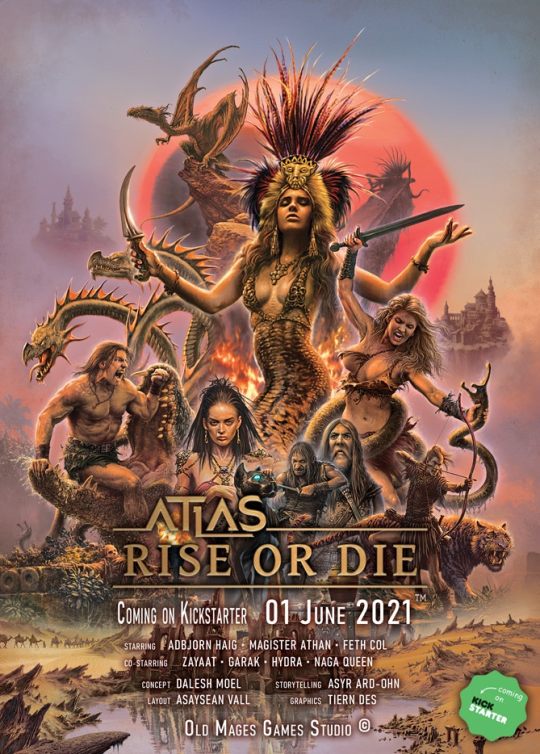
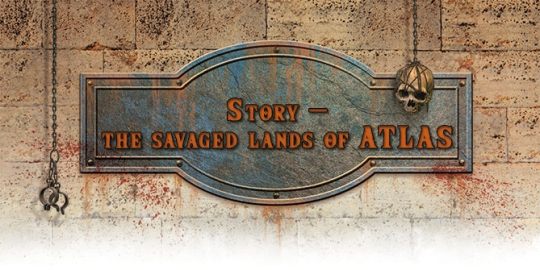
"Only a few understand adventurers. Most consider us insane driven by treasures, ancient secrets, fame, admirers, power, or what comes to mind. It couldn't be farther from the truth." /Adbjorn Haig/
Enter the cruel and savage world of Atlas, where the ruins of forgotten civilizations are desecrated as the strange bones of the past begin to stir. Dark rituals mixed with corrupt technologies animate the ashes of the dead. As bloodthirsty hordes of barbarians and beasts alike roam the plains, the stern land can never be satisfied by the sweat and tears of the innocent. Mighty despots pass the time with their concubines behind high stone walls. Metal and magic have formed the land, erected floating islands, and twisted the deadly mountain paths. Take all you can before others plunder everything in this land of limitless possibilities! Rise as a mighty warlord or rot away like a maggot! Join us in the world of Atlas right here, right now!
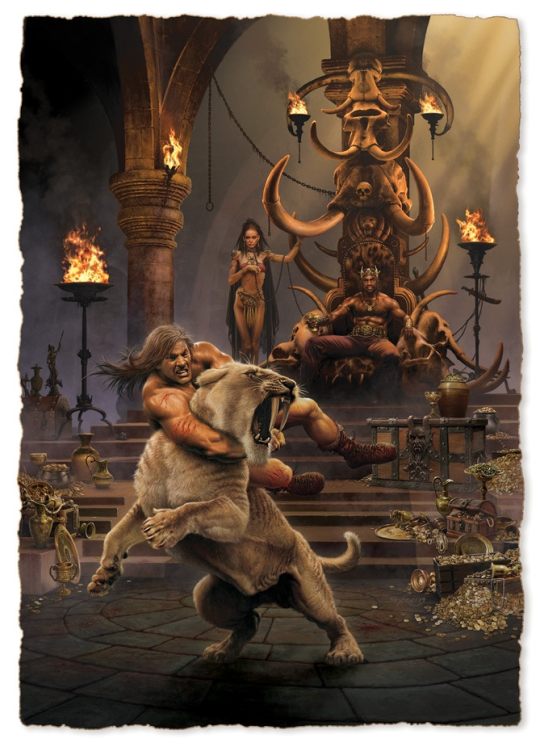
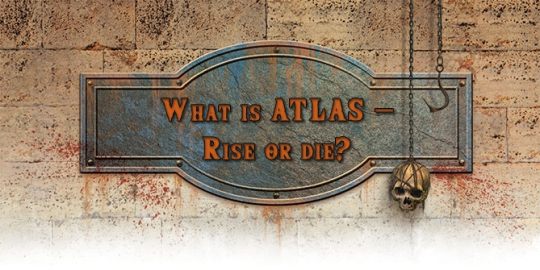
"I have seen many shitholes on my voyages." /Feth Col/
Atlas – Rise or Die is a classic, vintage sword & sorcery tabletop RPG. In its style and mood, Atlas brings about the renaissance of the epic RPGs of the '80s with a modern, clean design and breath-taking illustrations.

If you are interested, don't wait! Get a sneak- peek of the layout right now! Come and look at how we imagined the book's design and the base of the 2d10 system!

https://drive.google.com/file/d/1-e7_UOnNPa2cGsnwsowr55X9J2tFIPu1/view
The campaigns are housed in a brand new, progressive system that facilitates fast-paced and fluid gameplay. The system rests on the following seven main features:
A realistic, d20 compatible 2d10 system with low numbers. We believe that by using the result of rolls with 2d10s, we can eliminate some of the radical distribution of values often associated with d20s. This makes "Nat20" rolls even more epic and memorable, since their chance decrease from 5% to 1%.
We use a three-dimensional (race, class, archetype) character creation system, where by removing the traditional "alignment" aspect of characters and introducing the archetype system, well-rounded personalities can be created and played out.
The Atlas system allows for completely free character advancement, even maxing out a single stat is possible, though not encouraged by the system. It favors balanced characters and allows unique combinations of strengths and weaknesses.
Subsystems for NPC interactions, that allow overcoming obstacles by not only violent means. These make social interactions and investigations as enjoyable and manageable as combat encounters, resulting in immersive role-playing.
The XP system supports actual role-playing, not only combat.
The combat system is fast-paced and not roll-heavy. Alongside customary mechanics for damage distribution, it also emulates the dynamic physical positioning of combat participants. Combat maneuvers, boosts, and the decisions made in a fight scene this way become a fun activity instead of brainless rolls and damage calculation. Aiding our teammates and getting them in position come with substantive strategic rewards.
D&D 5th Edition compatible Setting on a brutal, bloodied, barbarian world of ancient technologies and dark rituals
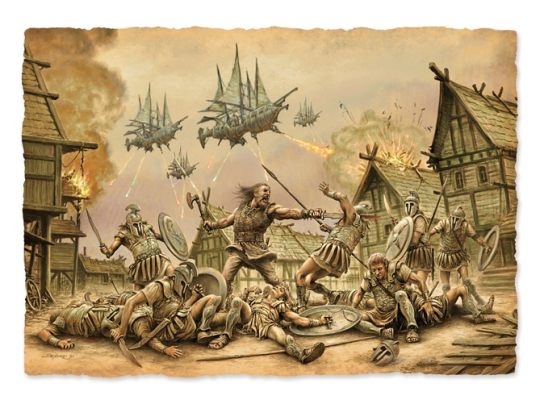
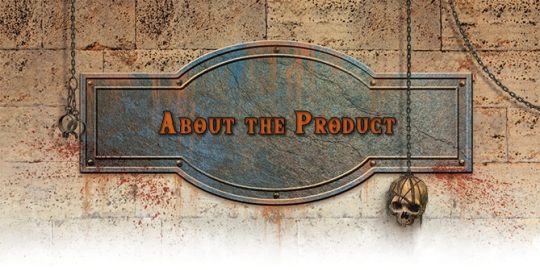
“A great sword consists of three parts. You grab the grid, you defend with the middle and you kill with the point. It can’t be simpler.” /Adbjorn Haig/
Frankly speaking, ATLAS- Rise or Die, is not one but THREE unique books merged into one revised and united volume.
The first part is the Corebook which contains the basics of the game. This includes descriptions, explanations, added tables, and examples. All the presented sub-systems represent one, merged system that can be used as a core for any alternative games. It is with 5th Edition and with d20 system also compatible.
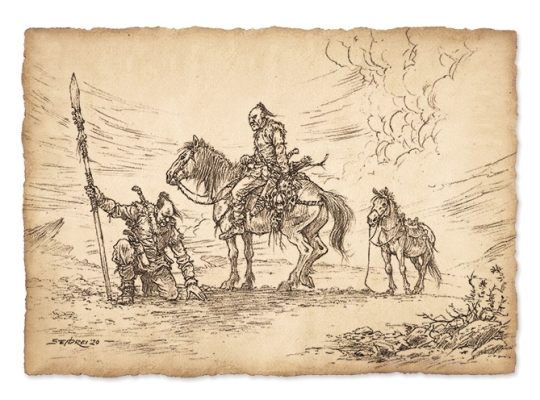
The second section is the Player's Handbook. This contains detailed information for players to create their character through the Handbook's unique 3D character creation system. Roles, Races, paths, highlighted classes, and much more are included in this book. Everything listed above serves the ultimate purpose of exclusive character creation to ensure that each player generates their unique character that is entertaining and cool to play with.
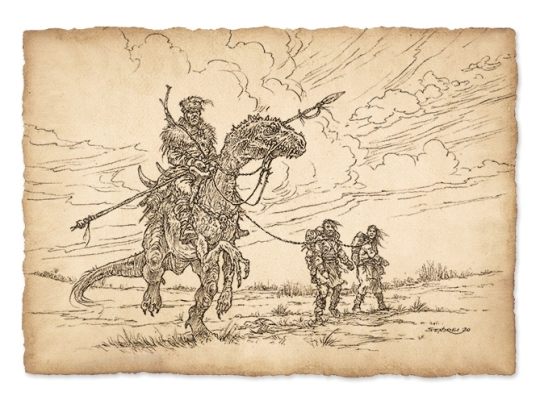
The third and last book is called Setting, which presents the wonders and dangers of ATLAS, a description of places, creatures, and everything that can be found on this barbaric land. It is full of adventures bringing you forgotten treasure, ancient monsters, and thrilling legends. The descriptions in this edition contain all the information a player needs to survive this brutal world. It is also "5th Edition-friendly".
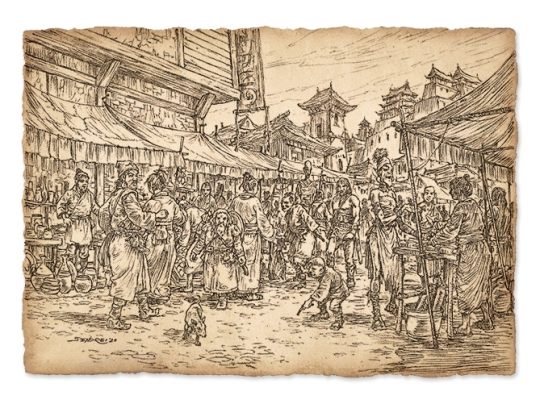

All this will be brought to you in an old-fashioned hardcover book with the following parameters:
Hardcover, straight spine book
Classic portrait A/4 size
Matte art paper- core pages for stunning looks and to be easily readable
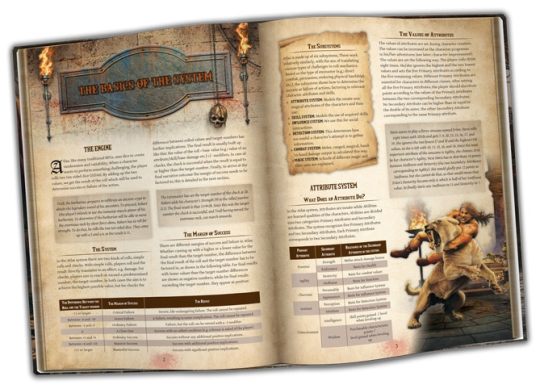
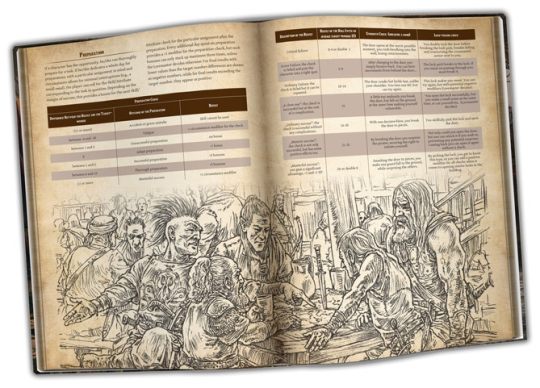
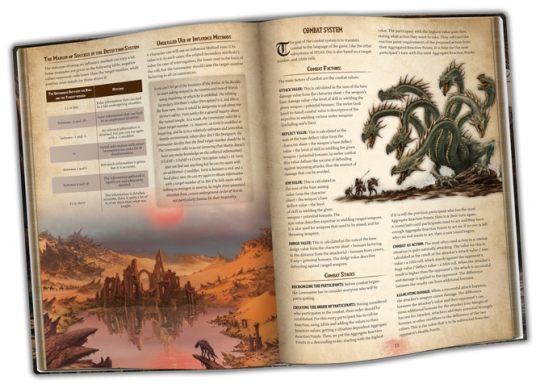
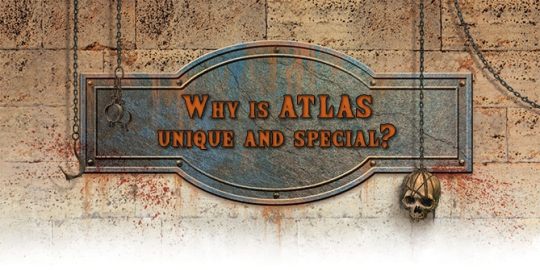
"When Enoon, our Dark Sun, arises, it shakes the calm waves of magic with its power. At such times, numerous disconcerting events manifest themselves all over Atlas." /Magister Athan/
Atlas – Rise or Die is more than another boring remake. Our goal is to bring back the atmosphere of classic game sessions in a unique new format, never seen before, through a completely modern, fresh, and trendy gamebook.
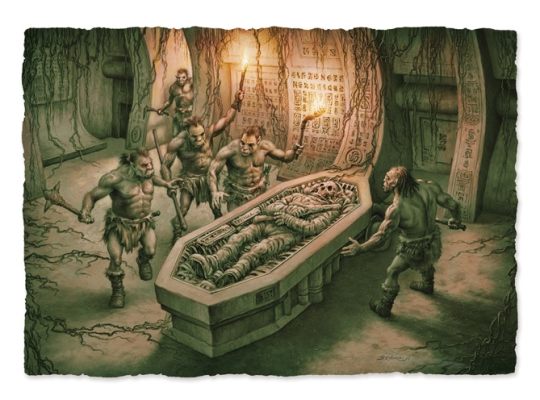
We are aiming to evoke a retro, vintage feeling with our design, all the while using high-quality, contemporary graphics, that would not have been possible in the ’80s.
Our own 2d10 system is less random and unpredictable than the classic d20, but it offers the same ease when it comes to calculation and keeping track of events. By using two ten-sided dice, average rolls are more frequent and exceptional rolls, like natural 20s, even more valuable - but is with D&D 5th Edition compatible.
We were adamant to retain as much as we can from the proven template of classic sword & sorcery RPGs while adding a few twists to make them better suited for the brutal world of Atlas. Our elves for example are sickly, degenerate nobles who rule their people through intrigue. Their savage relatives are bloodthirsty head-hunters, protecting their ancient forests and hunting down all intruders. The dwarves are tyrannical conquerors at the head of an enslaved populous, dwelling in underground fortresses, that they call cities. They often make deals with subterranean creatures only to have their aid in their territorial clan wars.
The fast-paced, narrative, and tactical combat system goes a lot further than the classic, "attack roll–damage roll" format. The combat maneuvers infused in attacks alongside the collected bonuses make combat less hectic, more enjoyable, and realizable.
It is not only the lovers of fight sequences who can find something to please them. We have developed influence and intuition systems to support non-combat situations, which give flexible frameworks for meaningful interactions, information-trade, and realizing player goals through NPCs.
In the world of Atlas, everything is about brutality and blood sacrifice, and so it is with our magic system. It is optimized for coming up with unique combinations, while it supports the creation of your own spells. Magic twists and drains its user, should they become too greedy, the price could easily become their lives.
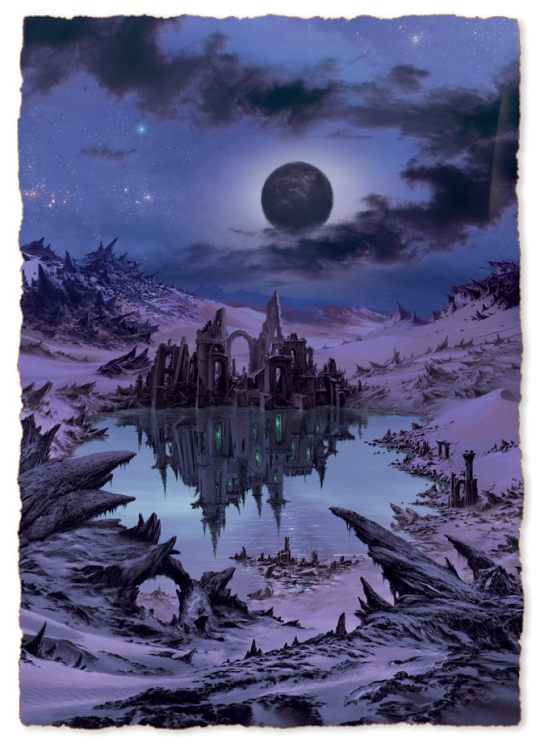
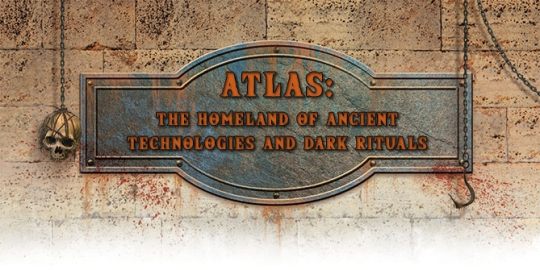
“Atlas is a cruel violent world, where barbarism, blood, and brutality dominate. But it wasn't always like that... A long time ago, ancient civilizations, advanced races, and rich kingdoms ruled this world, using their magic and technologies, rather than cold steel and muscle power.” /Magister Athan/
ATLAS is much more than a simple sword and sorcery world. It was shaped by barbaric realms, ancient monsters, and pioneer spaceships from forgotten civilizations.
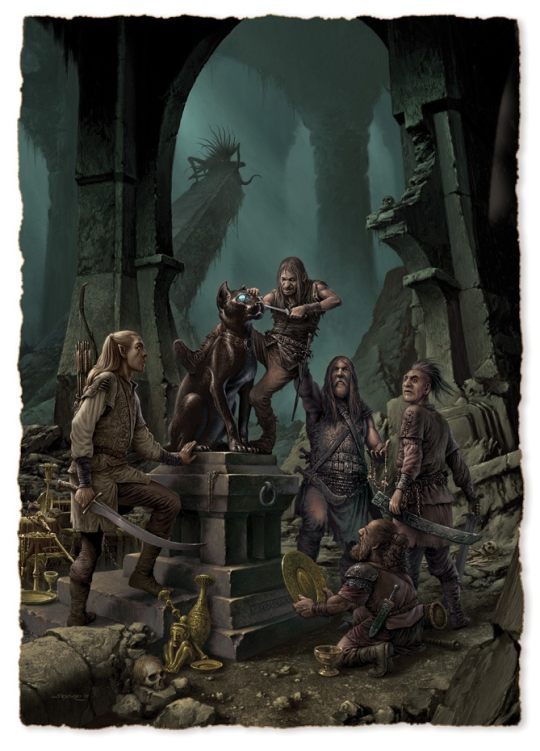
Kickstarter campaign ends: Thu, June 24 2021 11:00 AM BST
Website: [Old Mages Games] [facebook] [instagram]
17 notes
·
View notes
Text
Fate and Phantasms #138: Elisabeth Bathory (Brave)

It’s Halloween again, I guess, which means it’s time for yet another Elisabeth Bathory build! I promise I won’t mess this one up so bad it needs a redo. It’s about time we made a totally normal adventurer build. Now go forth, brave adventurer! EXP awaits!
>Play >Settings
Next up: Dang ol’ Ron Paul 2: Egyptian Boogaloo
Race and Background
Winged Tieflings make everything so much easier for Liz builds, don’t they? As one of those, you get Darkvision, Hellish Resistance against fire damage, and you’re Winged, giving you 30 feet of flying speed when not wearing heavy armor. I think you can manage that.
You also get +2 Charisma and +1 Dexterity (thanks again, Tasha!)
You’re also still a Noble, giving you History and Persuasion proficiencies.
Ability Scores
First up: Dexterity! Get that as high as possible You’re good with a shortsword and you’re adventuring in... I can’t even call it light armor with a clear conscience. After that is Charisma, which explains how you suckered DW into giving you another Halloween event. Your Constitution’s also pretty good, you just have to pop a couple quarters in for another life. Your Strength isn’t terrible, you need that to carry around your party in a single sprite. Intelligence isn’t your strong suit, that’s the mage’s job. Finally, dump Wisdom. ...Yeah.
Class Levels
1. Fighter 1: Fighters get all sorts of neat stuff, like proficiency with Strength and Constitution saves, Animal Handling for all those Deerlets you attract, and Athletics for those long walks through 30 floor dungeons.
You also get the Dueling fighting style, which makes your sword and board a little more sword, giving one-handed weapon damage a +2 bonus. You also get a Second Wind once per short rest that lets you heal yourself as a bonus action. Healing factors are all the rage in modern games nowadays.
2. Sorcerer 1: You’re still a sorcerer so we can get all your dragony stuff, but this time instead of your dragon blood we get our powers from Wild Magic, unlocking your ultimate power Legend of the Crimson Heroine- I mean, Wild Magic Surge. Whenever you cast a 1st level spell or higher, the DM might make you roll a d20. On a 1, you get a random effect from the wild magic table.
You also learn to use the Tides of Chaos to your favor, gaining advantage on an attack roll, save, or check once per long rest. This can also be recharged by the DM if they force you to roll on the wild magic table after casting a spell.
Speaking of, you get Spells as a sorcerer, which use your Charisma to cast. Light and Message work as your trusty in-game flashlight and chat client, while Booming Blade, Thunderclap, and Thunderwave act as your sonic breath attacks. You also get Mage Armor, making your outfit slightly more practical with an AC of 13 plus your dexterity modifier.
3. Sorcerer 2: Second level sorcerers are a Font of Magic, giving you a pool of sorcery points equal to your sorcerer level each long rest. Right now this is extra fuel for your spell slots, but later you’ll have more to do with this feature.
You also get Chaos Bolt for extra randomness! Deal 2d8+1d6 damage of a random type, and it might even hit multiple people!
4. Fighter 2: Second level fighters get an Action Surge, it’s like quickened spell but better! It gives you an extra action in a turn once per short rest.
5. Fighter 3: Turn-based RPGs aren’t that complicated, so that suits your Champion fighting style well. Your Improved Critical means your attacks are critical hits on 19s and 20s now!
6. Fighter 4: Use your first Ability Score Improvement for even more Dexterity. Only 16 AC in a bikini? Those are rookie numbers!.
7. Fighter 5: Fifth level fighters get an Extra Attack each attack action. That’s two attacks per turn, four with action surge. I think we can speed things up even more though. Hold on a sec.
8. Sorcerer 3: Third level sorcerers can spend their hard-earned sorcery points on Metamagic options, ways to empower your spells beyond their normal limits. Quickened Spell turns an action cast spell into a bonus action spell. Now you can action surge for four hits and cast Booming Blade with the little bit of time you have left! Action Economy!
You also learn Empowered Spell to get the most out of your slots. This option lets you re-roll a couple of dice on a spell to help guarantee you’ll deal plenty of damage!
For your spell, Shatter gives you a stronger sonic attack that can rattle apart constructs and the like.
9. Sorcerer 4: Now that we’re learning some useful spells, it’s a good idea to make sure we can cast them while decked out. The War Caster feat lets you cast somatic spells with your hands full, and you get advantage on concentration checks! As a bonus, you can also cast cantrips as attacks of opportunity when you’d normally just hit someone.
This makes your new cantrip True Strike almost useful! But it’s still better to just hit people twice. You also learn Dragon’s Breath, giving you (or someone else) the ability to breathe fire, acid, cold, or the like. Sadly thunder’s not an option, but we’ve already got plenty of ways to deal with that already.
10. Sorcerer 5: Thanks to your Magical Guidance, you can spend a sorcery point to re-roll a failed ability check. You’re a video game protagonist, you’ve gotta be good at everything.
You can speed things up even more with Haste, which doubles your move speed, gives you a higher AC, and gives you another action each turn. You can only attack once with that action, but that just gives you an excuse to use Booming Blade more. The turn after the spell ends you’ve gotta spend a turn doing nothing, but that’s just the name of the game. (Actually the name of the game is Bravely Default, but that’s just nonsense.)
11. Sorcerer 6: Your protagonist powers are charged to the maximum, and now you can Bend Luck as a reaction, spending two sorcery points to add or subtract 1d4 to an attack, check, or save you can see. Nothing bad ever happens to the Bathorys!
You can also cast Tongues now, giving you the ability to open up the world’s options menu and translate yourself into whatever language you need.
12. Fighter 6: Back in your main class, you get another ASI that’ll bump up your Charisma for stronger magic. That’s a bout it, not every ability can be dex you know.
13. Fighter 7: As a seventh level champion, you are a Remarkable Athlete, letting you add half your proficiency bonus to strength, dexterity, and constitution based skill checks. You can also add your strength modifier to your running long jump distances. Nobody ever complains about sore feet in an adventuring party, and that’s because they’re all fit. Even the wizard. Don’t think about it.
14. Fighter 8: You know what? I don’t think we’re done cheating at dice yet. As the protagonist of your own life, you’re extremely Lucky, meaning you get three luck points per day. You can spend a point to re-roll an attack (either yours or one hitting you), or your own check/save.
15. Fighter 9: Ninth level fighters are Indomitable, letting you re-roll a failed save once per long rest. I don’t know if you’ve noticed a theme yet.
16. Fighter 10: Tenth level champions get an Additional Fighting Style, and Protection will make your sword and board a little more board. You can now use your reaction to impose disadvantage on an attack hitting you or a nearby ally as long as you’re wielding a shield. (or shielding, if you will.)
17. Fighter 11: With another Extra Attack, you can now strike foes three times per attack action! Really let’em have it.
18. Fighter 12: With this ASI, you can finally max out your Dexterity for the highest possible defense and offense. Good job!
19. Fighter 13: Getting another use of Indomitable is nice, if a bit lowkey. Like most fighter levels, tbh.
20. Fighter 14: Your final level gives you one last ASI to max out your Charisma for the strongest spells possible.
Pros:
With an AC of 20, the ability to force disadvantage, plenty of other ways to mess with incoming attacks, and oh yeah flight, you’re pretty hard to hit when you want to be. Which is always. Not bad, given the circumstances.
Speaking of, you have tons of options for messing with rolls. Add, subtract, reroll, it’s all good! Nobody will ever get anything done again if you don’t want them to.
Thunder is a great type to use when you need to cause some property damage without burning down the whole building. It’s also not as resisted as stuff like fire or cold damage, making it more reliable.
Cons:
A lot of your roll messing-with stuff is attached to reactions, making it hard to control anything in more crowded encounters.
Those that don’t use your reaction probably use your sorcery points, which you don’t have a lot of. You might have to learn... discretion! *dun dun DUN*
Your HP isn’t all that bad, but it’s not great for a melee fighter, especially if you want to stay close to other people to protect them. Thankfully you can just fly out of danger for the most part.
15 notes
·
View notes
Text
Felinette Month Day 7: Couple’s First
Felinette Month Day 7: Couple’s First
This might follow up with my New School, New Friends story but it’s not set in stone but the first scene is from when they meet.
D1 D2 D3 D4 D5 D6 D7 D8 D9 D10 D11 D12 D13 D14 D15 D16 D17 D18 D19 D20 D21 D22 D23 D24 D25 D26 D27 D28 D29 D30
~~~~~~~~~~~~~~~~~~~~~~~~~~~~~~~~~~~~~~~~~~~~
First Meeting
Marinette had just transferred into her new school after being bullied out of her last one. She had gotten to school early to get her schedule and now she was waiting for her new class representative. She decided to look over her schedule.
After looking over the schedule, Marinette looks up from her paper and notices a blonde boy making his way to where she and the front office lady are waiting. By the looks of it, the class representatives wear a different uniform than the other students. He had on a white-collar shirt, a black blazer with red buttons over it, red and black plaid pants, black shoes, a black and green watch, and was carrying a black satchel.
“Good morning Mlle Bauer” The boy greeted the front desk lady
“Good morning to you too Felix” Mlle Bauer greeted the boy known as Felix, “We have a new student starting today and I know you would normally only handle the business side of being a representative but Rosemarie had an appointment today she couldn’t miss”
“It’s alright Mlle Bauer, I knew about Rosemarie’s appointment,” Felix assured Mlle Bauer, “Now where is the new student?”
“Right here” Marinette giggled. She knew she was small, her mother is still half a head taller than her.
Felix’s eyes widen as he looks at her because he is one foot taller than her. “My deepest apologies I hadn’t seen you standing there”
“It’s alright, it happens all the time” Marinette reassured him, “I am 4 '11'’”
“I see well I apologize again Mlle?” Felix Inquired
“Marinette Dupain-Cheng” Marinette greeted the boy and extending her hand
“Felix Culpa” Felix introduced himself taking Marinettes hand and giving her a firm shake
First Confession
Felix and Marinette were hanging out at Marinette’s place after school. Felix had stayed for dinner at the recommendation of Sabine, he set a reminder on his phone about this day to tell his mother later about the invitation from Sabine. After dinner, Marinette and Felix moved to the living room while Sabine and Tom went to their room. They had just finished playing Ultimate Mecha Strike III. Felix lost immensely.
“How?, Marinette, How?” Felix exclaimed, “You had less than half your life”
“I’m Marinette” Was all Marinette said
“I’m starting to get that” Felix said with a smile
“Wanna watch some movies?” Marinette asked as she grabbed the remote in case he said yes
“Sure,” Felix agreed, “What movie do you wanna watch?”
“Let’s watch ‘To All The Boys I’ve Loved Before’, It’s such a good romance movie” Marinette suggested, “Or do you have a movie in mind?”
“No, I’m okay with watching that movie,” Felix assured her.
So they began to watch the movie and since it was already late Marinette began to doze off. So when Marinette finally fell asleep, her head fell onto Felix’s shoulder which surprised him. He then saw that she had fallen asleep so he moved her gently onto his lap. He stared at her sleeping face, forgetting the movie completely and carefully put his hand on her cheek.
“You came into my life without even knowing how much you would change it, you took your time in getting to know me for me and accepted me and my walls, you accepted my friends, you didn’t judge me for all my faults, you helped me with my anxiety, you are are the most caring person I got to know and before I knew it,” Felix whispered, “I had fallen in love with you”
First Date
Marinette was nervous, no, she was beyond nervous. She was feeling very anxious and excitable. The reason being was that she was finally going on a date with Felix. So she called the girl squad over; Ruby, Terra, Allegra, Rosemarie, Jake, and Nyx. They were helping her get ready for the date and helping how she was going to do her hair. Marinette was trying freaking out and was changing in and out of a lot of outfits behind the room divider freaking out, Ruby was on Marinette’s bed laying on her stomach, Terra and Allegra were on each other on Marinette’s lounge, Rosemarie and Jake were sitting on the floor, Nyx was in the computer chair. They were watched as Marinette was freaking out on what to wear when Ruby decided to interrupt her rant.
“Do you know where he’ll be taking you?” Ruby asked Marinette
Marinette stopped and looked at her then looked at the others before responding, “All he said was to dress formally but not too formal.”
“Let us raid your clothes to combine a perfect outfit,” commanded Rosemarie
Marinette sighed in defeat and nodded her head. Jake and Terra looked through her shirts, skirts, and dresses, they found an empire red dress. Rosemarie was looking through the jackets and coats she found a black short long sleeve dress jacket. Allegra was looking through bracelets and earrings and found a gorgeous black bracelet that went wonderfully with the simple black dangle earrings she also found. Ruby was looking at the shoes and trying to find ones that would look great with the empire dress along with looking for the perfect bag and she found red 3-inch heels and a red and black wallet purse. Nyx was in charge of Marinette's hair, nails, and makeup so she got to work on Marinette's nails so they had time to dry so she painted those a red shade, gave her a natural look with slightly dark lipstick and had put half her hair up with a hairpin and curled her hair.
They had just finished when Marinette's mom called to them that Felix was there. So the group headed down first and gathered next to Marinette's mom. Then Marinette came down looking more gorgeous than normal leaving Felix breathless.
“For the first time, I understand the difference between pretty and beautiful,” Felix said
This made Marinette blush and the group squeal. Sabine then took some photos and sent the couple on their way. Felix opened her side of the limo and then went to his side and they were on their way. They arrived at the restaurant and to them, it felt natural. There were no first date jitters, no nervousness that was there before, and no awkwardness.
After dinner, they had walked around Paris and ended up underneath the Eiffel Tower. Where they danced, laughed, and had their moments. They were having the time of their life and they didn’t want it to end.
First Fight
Felix was running. He had just seen Marinette being held by Adrien in what seemed like an intimate hug and he didn’t know what to think. Marinette had let go of Adrien and was just about to say goodbye when she saw Felix in the corner of her eye. Both their eyes widened and Felix began to take a few steps back before running away with Marinette calling his name and running after him leaving Adrien just standing there.
“Felix, Slow down” Marinette yelled to him.
Felix ignored her and kept running until they ended up under the Eiffel Tower and Marinette tackled him. She then used her strength to hold him there so they could both catch their breaths. The streets were almost empty with it being 8 pm.
“Marinette let me go,” Felix commanded, “How are you holding me in place?”
“Shut up and listen,” Marinette demanded, “Whatever you think you saw was not the thing you saw”
“Really because what I saw was you and Adrien in an intimate embrace,” Felix accused her, “What do you still have feelings for him?”
“Felix I told you it wasn’t like that,” Marinette told him
“What was it Marinette because I don’t know what to think anymore,” Felix asked
“What you saw was me rejecting him,” Marinette answered
“Really because it didn’t look like it to me,” Felix scoffed
“Well that’s exactly what it was and if you can’t accept that then call me when you calmed down and actually thought about how I’m with you because I want to be with you,” Marinette hissed at him finally releasing him and getting up.
Marinette walked away to go home leaving Felix on the ground with his thoughts.
First Kiss
Felix and Marinette were on another date just walking through Paris while there was a light drizzle of rain so they weren’t really getting wet. Marinette was wearing a pink v-neck strap top, white dotted skinny jeans, a red wine cardigan, white heeled shoes, a pink hobo bag, disc earrings, and a disc necklace (this). Felix was wearing a white button-down dress shirt, essential chino pants, Justin sunglasses, rugged handcrafted lace-up boots, and a black wool overcoat (this). They were walking, holding hands, and talking.
“It’s such a wonderful day for a walk,” Marinette commented as the began to arrive at the Eiffel Tower. There was a street band playing some music.
“It is,” Felix agreed, “remember how on our first date we danced under here”
The street band began to play ‘Perfect’ by Ed Sheeran and Felix took Marinette’s hand they began to dance to the music. The few people who were there stopped and began to watch with a few taking out their phones and recording them. As the song finished and as did their dance they finished it with a kiss. They pulled away when they heard the claps of their audience and both blushed as they bowed.
First ‘I Love You’s”
Marinette and Felix were just hanging out and having a picnic at the park near Marinette’s home. They were both doing their own thing when Felix stopped reading his book and just stared at Marinette. Marinette was designing and was so focused on what she was doing she didn’t notice Felix staring. Meanwhile, Felix was enjoying the view of Marinette in her element. He adored her and would do anything for her.
So before he knew it he spoke saying, “I love you”
This made Marinette snap out of her focused faze and stare at him. Felix meanwhile was freaking out because he just said ‘I Love You’. They stared at each other for a moment with both having wide eyes but Marinette was also gaping.
Marinette then launched herself at Felix and gave him a kiss before whispering into his ear, “I love you too”
~~~~~~~~~~~~~~~~~~~~~~~~~~~~~
D1 D2 D3 D4 D5 D6 D7 D8 D9 D10 D11 D12 D13 D14 D15 D16 D17 D18 D19 D20 D21 D22 D23 D24 D25 D26 D27 D28 D29 D30
#felinette#felinette month#felinette month day 7#Couple's First#marinette dupain cheng#felix culpa#a bit of Adrien
34 notes
·
View notes
Photo
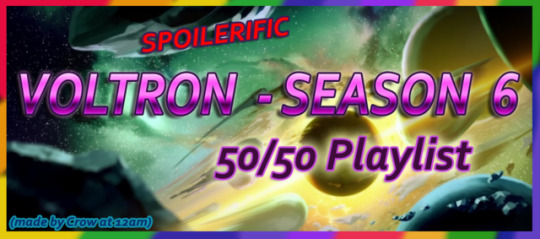
half shitpost. half serious. all playlist.
I decided to unceremoniously break the one rule I set for myself every single time a new season of this show is released, which is TO NOT POST SPOILERS EVER, because I figured this was too fun not to share. So, instead of outright filling your dash with my critical & ridiculous thoughts, I’ve composed them into musical format via a YouTube mixtape. It’s 27 songs long and will take about an hour and a half of your life.
Keep in mind that this playlist is FILLED WITH SPOILERS. Even though it’s mostly a joke-y song-inspired summary of the events in S6, please do not listen to the playlist until you’ve watched the entire season. It will make 0 sense, as opposed to the minuscule fraction of sense it would’ve made if you had finished watching. Plus, you’ll be mad that you ruined it for yourself. It’s honestly an interesting collection of episodes!
However, if you are indeed ready, listen to it here!
https://www.youtube.com/playlist?list=PLgZlbfm6-3v1V5C74fT9uwDZmWroOczHR
(bonus link if the first doesn’t work)
I recommend going in blind and letting it play through without reading the descriptions below until you get to the song, but if you’d rather know EXACTLY what was going through my mind when I slapped everything onto the tracklist beforehand, go wild.
MIGHTY MORPHIN' POWER RANGERS
I just wanted the thumbnail tbh, but this is a good intro track for the mess you’re about to experience.
E P I S O D E 1 - OMEGA SHIELD
MULAN - I'LL MAKE A MAN OUT OF YOU
Hunk training w/ Dayak. This one was probably the most visceral song. It was stuck in my head the absolute second he held up those weights.
BONNIE TYLER - TOTAL ECLIPSE OF THE HEART
Shielding the labor planet from the solar sequences (eclipses are tangentially related, right?) and also a very dramatic way of backing Lance getting saved by Allura.
E P I S O D E 2 - RAZOR’S EDGE
TAME IMPALA - CONFIDE IN ME (KYLIE MINOGUE COVER)
Allura slooowly trusting Lotor more and more & them being awfully flirty. In a serious sense, this is about him convincing her to let down her guard and let him in on what he wants to have.
CELINE DION - ALL BY MYSELF
Lance getting third wheeled hardcore by Allura & Lotor :( poor dude can’t catch a break.
THE WEEKND - STARBOY (ft. DAFT PUNK)
Keith coming to terms w/ Krolia. I also needed a generally serious jam so this was a good fit to fill the space.
Have you seen that one Lance fanzine by the same name though? Holy shit. The art is incredible.
QUEEN - DON'T STOP ME NOW
Keith & Krolia again, this time ft. them living together for 2 yrs on top of a giant space whale with a bootleg Blink Dog for a pet.
WOODKID - THE GREAT ESCAPE
Krolia & Tex (Keith's dad, still nameless smh) and how they were total badasses together. This is a mix between shitpost and serious because I couldn’t think of anything country/southern-related that fit the bill for their “let’s run off and hide and be together” scenario except for this song. Stuck with the horse metaphor, I guess. :P
THE KILLERS - READ MY MIND
Focus on Krolia & Tex's relationship again, her leaving him for the good of the planet and such. The lyrics are really good here, mainly
The teenage queen, the loaded gun The drop dead dream, the Chosen One A southern drawl, the world unseen
E P I S O D E 3 - MONSTERS & MANA
SKYRIM 8-BIT THEME
for Monsters & Mana aka BEST EPISODE. I can’t believe how nerdy they went. And how accurately nerdy they went. d20s..... playing the same classes after dying.... losing 8 hours in what feels like 8 minutes... Tomb of Horrors... they got it all.
SKRILLEX - REPTILE
CORANIC DRAGON BOSS FIGHT! ‘Cause it’s a giant, fire-breathing reptile.
NITRO FUN & HYPER POTIONS - CHECKPOINT
basically just outro-ing Monsters & Mana. I gotta say, I thought this was the best downtime episode in a while. Maybe not as fun as Space Mall, but really close.
It could also be my favorite because I have 60 D&D characters... :/
E P I S O D E 4 - THE COLONY
AC/DC - BACK IN BLACK
Keith returns not only in his dark black Blade of Marmora suit but also to reinstate his role as the Black Paladin for the time being. Kuron’s nearly confirmed as a danger at this point!
THE BEACH BOYS - WOULDN’T IT BE NICE
Romelle telling the tale of their supposed “messiah” being Lotor and all the abuse the missing Alteans went through. I wanted to get a song that accurately captured my emotions of “what the fuck” but nothing I had could match the tone. So why not go for the opposite?
FALL OUT BOY - HEAVEN'S GATE
def Allura & Lotor, mostly Allura thinking that he's finally the one. “Boost” in the lyrics probably refers to Lotor subtly trying to get out of the immoral shit he did in his past that she doesn’t know about yet.
HOE DON'T DO IT, OH MY GOD
they f u c k i n g kissed are you KIDDING ME, FOR REAL????
THE GUESS WHO - UNDUN
Everyone telling Allura that Lotor, her bf for all of 2 seconds, is actually a manipulative bastard who not only murdered but isolated and horrifically tortured thousands of her kind. You know, the kind that she believed was entirely EXTINCT except for her and Coran? Oops!
I DON'T KNOW HOW BUT THEY FOUND ME - MODERN DAY CAIN
Lotor betraying the team but AT LAST revealing exactly where he stands. He’s been so ambiguously untrustworthy for so long that it feels nice to get some closure.
Allura yeets him across the castle ship and it’s a work of art.
E P I S O D E 5 - THE BLACK PALADINS
SKILLET - FALLING INSIDE THE BLACK
Keith + Kuron/Shiro fight, alluding to the episode title and both of them literally “inside” of the Black Lion later on. Almost as edgy as their blades.
WOODKID - I LOVE YOU
Keith & Shiro, Keith doing his “I know you’re in there” plea. BROGANES FOREVERRRRR.
god that scene made me cry.
E P I S O D E 6 - ALL GOOD THINGS
TCHAIKOVSKY - 1812 OVERTURE
Coran & Pidge pulling off the craziest technical stunts and saving the day. I figured I needed at least one purely instrumental song on here.
CRAZY FROG - AXEL F
Keith goes nyoom, aka he asks Shiro’s spirit to help him get back to the Paladins. But nyooming feels right, just like the narm.
E P I S O D E 7 - DEFENDER OF ALL UNIVERSES
BLOC PARTY - HELICOPTER
Fighting Lotor and his knockoff Voltron. The lyrics in this one reference him ultimately becoming the father whom he despised so deeply. Sweet, sweet psychological revenge.
GLORIA GAYNOR - I WILL SURVIVE
Acxa, Zethrid, and Ezor getting tired of Lotor's shit and betraying him again. It’s a pretty snazzy battle anthem.
P.O.D. - BOOM
The Castle of Lions is destroyed (BOOM!) & Lotor is maybe dead. Action-y song for AWESOME animation.
EVANESCENCE - BRING ME TO LIFE
Allura reviving the hell out of Shiro. He’s back! Probably! And with white hair!
STEVE AOKI (ft. FALL OUT BOY) - BACK TO EARTH
We're going home.
That’s it! Thanks for listening. Feel free to send me a message telling me what you liked about the playlist; I had a lot of fun working on it for the day. Eventually I’ll post some 100% serious mixes... including lots more actual lyric analysis. Next time you’ll see spoilers from me will be July 15th, 2018!
#voltron#voltron season 6#voltron s6#voltron spoilers#voltron s6 spoilers#playlists#p#i'm posting this now in the dead of night because I know I wouldn't ever do it while I'm awake lol#I PROMISE THIS IS THE ONLY SPOILERY THING I WILL POST THIS MONTH#or uh#you have full permission to spam me with various photos of cups placed uncomfortably close to precarious edges.#anyways there are also notes in the YouTube description but due to it being finicky and no one noticing them I've decided to just stick them#verbatim into the post itself; plus some extra stuff just for u#enjoyyyy
6 notes
·
View notes
Text
DEFINITELY Vecna
okay so as a general starting point: in D&D you have CRs (Challenge ratings, a number between 0 and 30, that gives you a general idea of an enemies difficulty to fight. they’re not always reliable since DMs can tweak stats to fit their parties but they’re a good starting point to get an idea of the enemies)
the mind flayer is actually not a super special monster there’s multiple of them (they’re still classified as rare tho) they're also called Illithids and they’re Nothing like the one we see on ST. they’re basically of human size and weight (with tendrils as a face, so the design is a bit similar in that regard). also fun fact: they tend to show up with “followers” they have mind control over, so the whole possession thing the MF pulls in ST is absolutely on brand. ultimately a mind flayes CR is 7
and then you have Vecna who is completely unique. there’s only One (ha) Vecna. and he’s been an elusive evil since e1 (= Edition 1, that would be the edition of D&D the party is playing. early 80s. the most recent edition today would be e5 for reference) in e1 Vecna wasn’t even a fightable enemy and he just got referenced as a background evil (the mind flayers were already enemies since e1 btw). only in e2 (late 80s) did he actually become a real enemy with stats. and oh boy the guy has nothing on the mind flayers. i’m not sure if his stats we’re the exact same in the 80s since they sometimes change over editions but in e5 he would have a CR of 26. as far as i know he was also classed as “demigod” back in e2 but i’m not very familiar with that
so 7 to 26 (again highest is 30)... yeah Vecna wins. by FAR.
but they’re also no match in other stats (take the numbers with a grain of salt here i had to look them up and i struggled to find accurate numbers for e1 and e2 right off the bat so they might vary slightly for the earlier edition)
you’d have AC (armor class) -> MF 15 and Vecna 18
it’s even more intense in HP -> MF 71 (with roll +13) and Vecna 272 (with roll +128)
and saving throws for Vecna are also all between 12-15 while the MFs saving throws are all between 6-7 -> a saving throw is the lowest number you have to roll with a d20 (so the highest you could roll would be 20) to resist a negative effect and avoid damage. the combat system in e1 is different than today so i don’t really know how saves worked back then for sure. but the high requirement for saves is why the entire party including Mike goes down in Eddie’s game. you’d have to consistently roll really really high to avoid damage and the longer the combat goes on the more sure you are to start missing saves (even the game sequence we see in s4 shows that directly when we see Mike immediately take a hit after presumably failing the first save right away)
tl.dr: Vecna really wins in every regard. but that’s in large part because Vecna is essentially a boss enemy while the mind flayers are rare but not one of a kind. Vecna is a Super big thing in D&D, that’s the same guy people call “the Arch Lich” and “the Undying King” so he’s going to be Hard to beat
If you play DnD could you explain to me if Vecna or the Mind Flayer is stronger in game?
#oops this turned out longer than i meant to#have to add again that i have Very little experience with e1 and e2 so i tried to look up CRs Acs and HPs quickly#but they might be off a few numbers bc edition change etc#i haven't gotten into dnd in ages so i might be a bit rusty in some aspects but this should be the general idea of it
5 notes
·
View notes
Text
second to last of the full casters even though they really aren't, the warlocks:
feel free to share your reasoning/propaganda. warlocks have a high percentage of multiclasses, at 50%. half of those are just emily axford's multiclasses.
#dimension 20#ultimate d20 class fight#fig faeth#d20 leiland#sofia lee#lapin cadbury#iga lisowski#squing#pinocchio#karna solara
83 notes
·
View notes
Text
This is the Way: Choosing a Core Rulebook for Your Star Wars Campaign
Did you like The Mandalorian? Do you want to play in a campaign that is similar to the show? Did it pique your interest in playing a Star Wars RPG but you don’t know where to start? Are you interested as playing as a Mandalorian? Have you played D&D and wanted to give a Star Wars game a try? If so, this series will show you The Way!
In this article, I will explain the different core rule books published by Fantasy Flight and why you might choose one over the others. Regardless of which system your friends or DM chooses to run, thankfully you can play as a Mandalorian regardless of which system you’re playing in. Future articles will discuss differences with D&D, character creation, and various builds. I will skew things towards the Mandalorians since they’re my favorite Star Wars faction.
When it comes to Star Wars roleplaying games there are a lot of options, even a D20 one based on 3.5. I’ve had fun DMing but if you’re looking to play a campaign that captures the feel of Star Wars I recommend The Star Wars Roleplaying Game by Fantasy Flight. It is composed of three different core rulebooks — you only need one of them to play. It’s a bit different from a D20 system so there are a few things that may be confusing to someone who has played only D20 systems like 5e. I’ll cover some of the differences later. Thankfully the basics are identical and it’s very interchangeable regardless of which core set that your party uses, unlike the OOP Warhammer 40k RPG books that Fantasy Flight had previously published.
Ask yourself and your group what kind of Star Wars game do you want to play? Despite what some people think there are really different elements to Star Wars. Some love the dichotomy between the Jedi and Sith while others prefer emphasizing the War in Star Wars. Others like the political intrigue or playing a Western in space. So, this is something that should be discussed in Session 0.
There are other questions that must be answered including what time period people would like to play in. So far the rules have mostly covered the Galactic Civil War, but they could easily be adapted to take place before or after the OT series. There also has been some work done on the Clone Wars namely Rise of the Separatists and Collapse of the Republic. Another thing to consider is what kind of party everyone would want to play: Do you want to play a party of force sensitives trying to evade the Empire? Would you like to be a band of bounty hunters looking for their next score? Would you like to support the Rebellion against the Empire? The answer to these questions will determine which core rules your group would be best suited for.
The three core books have slightly different campaign mechanics but they overlap very well, so you can take races, classes, and weapons from separate books, even ones meant for the other core rule books! So it’s quite possible to play a force-sensitive character in a Rebel cell or one that fell in with a smuggling operation. The main difference is the group mechanics and flavor.
Age of the Rebellion was the second core book to be released but is often the first that people think of. As the name suggests you work for the rebellion and are attempting to take the fight to the Empire. As you work with the rebellion, you gain Duty which roughly represents how much trust the Rebel Alliance has with you. As you succeed with more missions and with your personal role within the rebellion they trust you with more and more resources. However, the more Duty you have, the more likely it is that the Empire will recognize you as a threat and therefore they will deploy more assets to destroy you. This book lends itself to a more heroic campaign and most closely parallels the original trilogy. It could also be used to emphasize the War in Star Wars so it can be darker if the DM wants to emphasize the darkness of war. So this is the set you would utilize if you’re looking to focus on the war between the Rebellion and the Empire.
It can also be adapted to the Clone Wars quite easily, just replace Duty for the Rebellion with Duty for the Republic or the Confederacy. Some have even adapted the ruleset to The Old Republic and Legacy Eras.
The first core book to be released was Edge of the Empire. Although you may participate in the Galactic Civil War, the emphasis of the book is on living in the outer rim, outside of the law, or in places that aren’t as impacted by the war. Whereas Duty is the driving force behind Age of the Rebellion in Edge of the Empire your character has Obligation. Obligation represents past obligations like old debts, belonging to a secret society, or abiding by a moral code. A great example of this in the original trilogy is Han Solo’s debt to Jabba the Hutt. Another great example is in The Mandalorian: Din follows a strict code of conduct and because of that he has to get Grogu to a Jedi. In Edge of the Empire, you can take additional Obligation in order to get even more XP or credits but this comes at a steep cost with in-game consequences. Edge of the Empire is generally grittier and greyer than the other two core books. It’s what I’d recommend if you wanted to play a game in which your character is just trying to make their way in the universe.
The third core book is Force and Destiny. Like its name implies its emphasis is on force-sensitive characters and running a campaign entirely based around them surviving the Empire. It has a morality system and there’s the possibility for a character or party to fall to the Dark Side and be redeemed. It’s possible to play force-sensitive characters in the other core books but Force and Destiny place them front and center. If everyone or the vast majority of players want to play Jedi or force sensitives, this is the core rulebook you should consider. It can also be a good start if one is looking to replicate Knights of the Old Republic.
The good news is that since the system is very flexible it’s possible to be a Mandalorian even in a Force and Destiny campaign: We know that the Dark Saber was wielded by a Mandalorian Jedi and this blade was often wielded by Mandalore or the leader of the Mandalorians. So even playing a Mandalorian Force wielder could be possible. Personally, I’m not so interested in playing a Jedi Mandalorian as it is very rare and any Mandalorians that were taken into the Jedi would really not be connected to the culture of the Mandalorians, which is what makes them Mandalorian. If you want to run a Mandalorian Jedi and the DM is lax, more power to you! But if you’re like me and you’d rather avoid breaking lore, you could still pull it off by making a Mandalorian who is force sensitive. One way that you can do this is by making the Mandalorians not even be aware of their force sensitivity and focus on force powers that increase their combat effectiveness. In particular, I am fond of the notion of the Starfighter Ace specialization. Basically, such a character would use their force sensitivity to be a better fighter pilot. If you didn’t want to play a force-sensitive character at all and had your heart set on a Mandalorian you could still tag along not unlike Canderous Ordo in Knights of the Old Republic.
Age of the Rebellion could have Mandalorian characters too. Sabine Wren is a great example of this. Mandalorians often find themselves on both sides of conflicts as we got to see in Rebels. We don’t know what happened exactly but we know it ultimately didn’t end well for the Mandalorians that took up arms against the Empire. If the Mandalorian was a bounty hunter or mercenary, perhaps the rebellion hired them at some point in time.
Edge of the Empire is most likely the system you’ll use if you want to emulate The Mandalorian. Its Obligation system fits in pretty well with Mando’s code of honor which is the driving force behind his actions in the series. Out of all three systems, this one feels the most like a Western. In my opinion, it also works out well if one is looking to do a campaign based around a heist, Noir, or simply exploring the galaxy. It works out pretty well if you want to play as a group of bounty hunters if your group is looking to play in a morally grey campaign, or somewhere that the law is weak like the outer rim, Nar Shaddaa, or heck even the undercity of Coruscant.
What are your thoughts? Is there a particular system you prefer? The next article I will write will be about the dice and difficulty, and how they differ from a d20 system.
This article contains affiliate links.
If you’re interested in playing I’ve put together some useful links! The Starter Sets have some pre-created characters, a small adventure, dice, and some tokens. The Master Kits have GM screens and some additional optional rules, for example, the AoR kit has a section on squad and squadron combat.
Age of the Rebellion Core Rulebook
Age of the Rebellion Starter Set
Age of the Rebellion GM Master’s Kit
Edge of the Empire Core Rulebook
Edge of the Empire Starter Set
Edge of the Empire GM Master’s Kit
Force and Destiny Core Rulebook
Force and Destiny Starter Set
Force and Destiny GM Master’s Kit
Star Wars RPG Dice
0 notes
Text
Blue Rose RPG 2nd edition: Introduction and Gameplay
Overview
The Blue Rose RPG is a creation of Green Ronin Publishing, with its first edition coming out in 2006. Recently they ran a Kickstarter campaign to release an updated edition that is available for $50 as a 384-page hardcover volume or $25 for a PDF. That may seem a little pricey, but it includes not just the information from the original basic game guide but also the extension book The World of Aldea which is about 140 pages. It’s also in full-color this time, with lots of new information on the setting, new NPC profiles, and an excellent new gaming system.
The book is written in a very easy style that doesn’t assume any previous RPG experience but also doesn’t condescend to its readers. It provides examples of all its gameplay rules and an extensive section on how to run the campaign as a Narrator. The only flaw in its format is that the section titles can be a little confusing, and you may need to refer to the table of contents regularly to keep track of where you are.
One of Blue Rose’s more well-known attributes is that it is very diversity-inclusive. The first edition included content for playing gay and bisexual characters and possibilities for polyamorous relationships. This second edition adds a section on playing nonbinary or trans characters, and makes use of its color illustrations to expand representation of people of color. In the first edition, for example, the gods of light look like this:

while in the second edition, they look like this:

(image source)
The other nice element of Blue Rose is where it falls on the simulation-game-story scale of RPGs, it lands much further on the story side than, say, D&D and its clones, which are somewhere in the middle. The goal has never been acquiring a “score” of experience points or acquired wealth, but rather completing an episode in a “series” where your character gradually advances by completing missions and stages of an extended sequence of adventures. The Narrator gets a lot of discretion in advancement in the rules.
Gameplay
However, the first edition still used a D&D-based engine, relying on a single d20 (20-sided die) for rolls, six ability scores and 25 skills with skill points, a host of feats, detailed weapon, armor, and equipment descriptions, and most of its monsters being straight clones from the SRD.
The second edition ditches this and instead uses Green Ronin’s in-house Adventure Game Engine (AGE), which I think is a better fit. And to get into the details of how the AGE works and why I like it, we’re going below a jump:
The AGE, rather than using a d20, relies on 3 six-sided dice (3d6) where the third (called the Drama Die) is a different color than the other two. The difference here is that with a d20, every number from 1 to 20 has the same chance of appearing. But with 3d6 your rolls from 3 to 18 look like this:

Ah, what a beautiful bell curve! Almost half your rolls will be between 9 and 12, essentially “average.” Since a typical difficulty roll is 11, that means you need to chose who does every roll based on who has the best ability in that area or a focus (more on that in a bit). That means cooperation, not personal glory. Completing the story together is what lets you level up, not being the one rolls a natural 20 and kills the monster.
Of course, it’s not all middle-of-the-road with this system, which brings us to that Drama Die I mentioned before. First, once you hit level six, you can use it to determine the measure of your success. If you succeed a test, you look at the drama die; a 1 means you barely passed, a 6 means you succeeded with flying colors.
Even before sixth level, you can use the Drama Die to have stunt points. Every time you roll doubles (which will happen 4 out of 9 times, yes I did math for this) you can use the score on your Drama Die (1-6) to see how many stunt points you now have. These points can be spent different kinds of "stunts” depending on your situation (combat, arcane, roleplaying, and exploration). If you score low, you only have a handful of options for bonuses on upcoming turns, extra actions, extra damage, etc. If you score high, you can blow them all on one major stunt or choose several smaller options.
This could easily become a mess, of course, but the book anticipates a number of problems off the bat. First, it has all stunts listed on two pages you can print out and turn into a double-sided card that can be passed to a player any time they roll doubles. While initially it might slow things down as they have trouble choosing, presumably the longer you play the more you know the stunts and can select them quickly. Second, it is ultimately the prerogative of the narrator whether stunt points even apply. While combat and arcane stunts are fairly straightforward and apply to many situations, exploration and roleplaying are only useful in some circumstances. If players try to abuse them by making as many rolls as they can to try to get doubles, then the Narrator can say that no stunts apply to this situation.
There are other ways to boost scores. Every player gets 3 conviction points at their first level to spend on rerolls and minor actions. They can get them back at the discretion of the Narrator when they think a player has earned it, usually by roleplaying based on their “fate” or “destiny” (which we’ll talk about in the next part during character building). Lastly, characters have to choose and build relationships, and if they are rated as intense enough they can modify how difficult an action is. It’s easier to psychically contact your best friend or lover; it’s easier to strike an opponent who is your mortal enemy. A higher intensity can give you extra stunt points for actions tied to that person, higher than the 6 your die can go to; with 7 stunt points you can pull off the intensity stunts of “As You Wish” for positive relationships and “Prepare to Die” for negative relationships (side note: heck yeah Princess Bride references!).
Abilities, Focuses, and Talents
In place of the six D&D ability scores (Charisma, Constitution, Dexterity, Intelligence, Strength, and Wisdom) the AGE uses nine. Constitution is pretty much the same. Charisma and Wisdom are more or less renamed to Communication and Willpower to better reflect their usage in the game. Accuracy - your ability to aim and strike things - is split off from Dexterity (coordination), and Fighting - combat ability - is separated from Strength. Perception - all those spot and listen checks - is now separate from Intelligence, i.e. what you know and how fast you learn. As in the original edition, there aren’t scores of 1 to 20 for abilities but rather bonuses starting from -2 to 4 (1 is average) that you add to test rolls. Ability points can be allotted in different ways, and the book provides three options for Narrators to choose from.
The bigger change is the elimination of skills and skill points. Skills in D&D have always been ungainly. Pathfinder reduces the number of skills to 19, and 5th edition D&D downplays them heavily in favor of just using ability score mods.
2nd edition Blue Rose just does away with them entirely and replaces them with “focuses” that you acquire from your race, background, and class. There are 82 possible focuses, more than you’ll ever have. Usually they serve to give you a 2-point bonus to an ability score. Example: anyone can gamble using their Communication Score, but if your character has a gambling focus (they’ve gambled a lot and know how to play well), they get a +2 bonus. Other times, though, you are required to have a focus to do a check on something. Example: you can’t just use Intelligence to make a check for sailing a ship if you’ve been landlocked your whole life, you need a Nautical Lore focus. Focuses can stack, and the Narrator will ask you to justify new focuses you add as you level up (i.e. I learned this on the last mission, I realized I was bad at this and did extra training or studying in between campaigns, etc.).
Feats from the old d20 version are now “Talents.” The 133 feats of the first edition (many of them branching, as one feat has another as a prerequisite) have been turned into 38 talents, each of which has three levels: journeyman, apprentice, and master. When you advance, you often have the option of taking a new talent or moving from journeyman to apprentice or apprentice to master within a talent you already have. It streamlines the whole process quite a bit.
All of these are of course tied in with character creation, which will be the subject of the next section...
2 notes
·
View notes
Note
if you've ever DMd, can you give some tips on how to make a good plot? im supposed to be DMing soon and I can't seem to come up with anything good
I have never DM’d before but @ghostering is one of my lovely DM’s and they kill it every weekend
My other DM (who is also wonderful and the one I played my first game with Hope this helps!
ULTIMATE GUIDE FOR OFFICIAL PUBLICATIONS: https://dnd.rem.uz/5e%20D%26D%20Books/ this link includes books like Rise of Tiamat and Curse of Strahd, Mine of Phandelver and pretty much everything for EVERY EDITION although I only really care about the 5e stuff but GUYS its amazing go download that shit before it mysteriously disappears from the interewebs!
https://www.youtube.com/watch?v=6XikjjQok5Y&list=PL7atuZxmT9570U87GhK_20NcbxM43vkom - Matt Mercer’s GM tips
https://www.youtube.com/playlist?list=PLlUk42GiU2guNzWBzxn7hs8MaV7ELLCP_ - Matt Colville’s tips and tricks for DMs - I highly recommend both of these palylists
https://www.reddit.com/r/criticalrole/comments/485sek/no_spoilers_matt_mercers_playlists_for_critical/?st=ivuo1ioo&sh=6f7a1b40 - Critical Role music (Mercer also uses Elder Scrolls music, I like to add Witcher stuff too)
http://www.wizards.com/dnd/files/DM_Experience_2011.pdf - this is a breakdown of a game run by Chris Perkins (works for Wizards of the Coast) and things he learend from that campaign
http://homebrewery.naturalcrit.com/ - this is for making your own pdfs for home brew stuff.
http://donjon.bin.sh/d20/magic/shop.html - this is a random generator for treasure, shops, taverns, even NPCs!
http://kobold.club/fight/#/encounter-builder - Exp generator
http://lunarmage.tumblr.com/post/150621458669/dnd-5e-homebrew-bard-college-of-trickery-by - a cool homebrew bard class
dnd-5e-homebrew.tumblr.com - Just a good tumblr to browse through for resources
http://www.wizards.com/dnd/tavern/Welcome.asp - random inn menu generator
http://inkwellideas.com/ - this is a gateway to a lot of stuff from random map generators to random encounters and things like that
https://www.patreon.com/elventower/posts?tag=underground - this guy makes maps available for download through his patreon
http://2minutetabletop.com/?s=dragon%27s+lair&post_type=product - more maps
http://inkarnate.com/ - a map making tool, more for large scale maps of regions and worlds
https://roleplayingtips.com/tools/1000-npc-traits/ - NPC traits
http://roleplayingtips.com/one-sentence-npc-generator/ - NPC generator
http://www.enworld.org/forum/dnd_view_block.php?id=1615 - NPC generator
http://roleplayingtips.com/city-encounter-generator/ - city encounter generator
179 notes
·
View notes
Text
Microlite78 First Edition Lite Expanded Second Edition (Tablet/Digest)

Publisher: RetroRoleplaying
Interested in the First Edition of the world's most popular tabletop fantasy roleplaying game, but put off by its seemingly random mechanics and design elements? Interested in trying some of the best known First Edition adventures with old school play but want to use the "better designed" D20-style mechanics you already know. The second edition of Microlite78 First Edition Lite is the game for you. These rules take the First Edition rules and filter them though the D20-based Microlite20 system to produce a conversion of the First Edition rules to a rules-lite D20-based system that encourages old-school play without strictly old-school rules.
This Expanded Second Tablet/Digest Edition of Microlite78 First Edition Lite is the ultimate version of the second edition of Microlite78 First Edition Lite. It is suitable for digest-sized printing or tablet viewing (pdf, epub, and mobi versions are included). This 1008 page digest-sized PDF includes new material not included in the standard (orin the "pay-what-you-want") version of the second edition of Microlite78 First Edition Lite, for example:
New (Optional) Classes: Alchemist, Commander, Monk, and Necromancer
120+ additional monsters
over 50 new magic items, including some magic items designed specifically for Microlite78 systems (e.g. items working with the hit point fueled magic system)
new spells, including 8th and 9th level spells for Illusionists
Additional optional rules
rules for using small parties of 1-3 characters in old TSR adventures designed for 8+ PCs
a sample campaign and several sample adventures (including a walk-through of creating a dungeon)
more advice (e.g. on environmental and terrain hazards) and random tables for Microlite78GMs
more art.
Of course, the Microlite78 First Edition Lite Expanded Second Tablet/Digest Edition includes all of the standard features of the second edition of Microlite78 First Edition Lite:
Simple Character Creation Rules: Roll 4 attributes and select a race, class, alignment and a background.
Basic Classes: Fighter, Magic-User, Cleric, Druid, and Thief.
Additional (Optional) Classes: Assassin, Barbarian, Bard, Druid, Illusionist, Paladin, and Ranger.
Races: Human, Dwarf, Elf, Gnome, Half-Elf, Half-Orc, and Halfling.
Simple and fast-playing combat system that tracks physical damage (aka body points) separately from luck/skill/fatigue (aka hit point) damage. Combat is BAB-based: no to-hit tables or THAC0.
Hit points recover with a night’s rest. Spells cost hit points to cast. Actual wounds recover more slowly.
Rules for hirelings, monster reactions (not every monster wants to fight), morale (not every monster fights to the death), and more.
Many optional rules (Advantages and Disadvantages, Psionics, Action Points, Sanity, more traditional magic and saving rolls, etc.): use none, some, or all.
A complete information on spells, monsters and treasure.
Gamemaster section with setting design information, and advice.
Rules for PC-ruled dominions.
Compatible with most other 1e based games and adventures -- as well as many designed for 0e, B/X, BECMI, and 2e.
The rules needed to create characters and actually play are short and sweet. Character Creation rules (including race, class, alignment, and background descriptions) are 48 digest-sized pages. The Core rules (skills, saving throws, magic, combat, experience and level advancement) are 22 digest-sized pages. They are written in fairly normal english, not "High Gygaxian". The rules assume that the GM understands the basic concepts of roleplaying games, but provides information for both the GM and the players on the various “old school” styles of play. Microlite78 First Edition Lite games can easily use adventures and material from early editions of the world’s most popular tabletop fantasy roleplaying game or modern clones.
This is the second edition of Microlite78 First Edition Lite. Core changes from the first edition: The Barbarian and Bard classes were added. The method of determining the number of experience points needed to advance no longer requires recalculating entire experience point advancement charts if optional rules are used. Treasure items are more like those of the first edition of the world’s most popular roleplaying game which makes the game easier to use with published adventures. Rules for character-ruled dominions are included. Gamemaster section with advice for creating and running campaigns added. Some artwork is in color.
Microlite78 can easily be used with all original first edition adventures and settings (as well as those for BECMI or second edition with a bit of work) as well as with modern OSR adventures and settings.
Microlite78 First Edition Lite Expanded Second Edition includes three files: a standard pdf and bonus epub and mobi ebook files. The digest-sized pdf is formatted in a single column and uses a larger typeface than the "pay what you want" version. It is suitable for printing or for easy reading on a tablet.
The epub and mobi versions of the Microlite78 First Edition Lite Expanded Second Edition contain tables and many ebook (especially epub) readers display tables in a single column unreadable mess. Epub reader software designed to display epub3 files usually have no problem with the tables. Note that tables in epub and mobi files may not adapt well to small screen devices. Some ebook readers do not display all of the art. The epub and mobi conversions have minor font size issues not present in the pdf version, but are quite usable if your ebook reader displays tables properly.
Price: $9.95 Microlite78 First Edition Lite Expanded Second Edition (Tablet/Digest) published first on https://supergalaxyrom.tumblr.com
0 notes